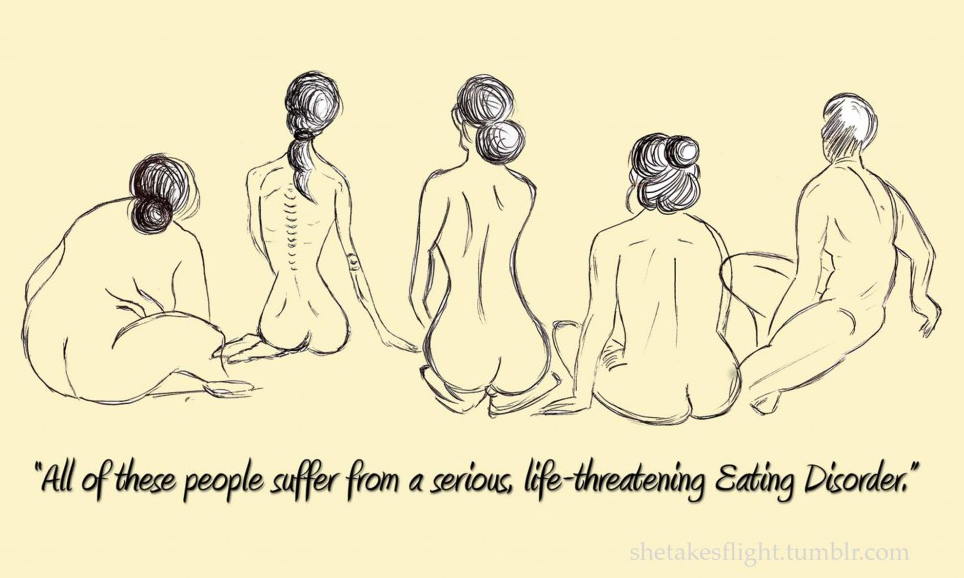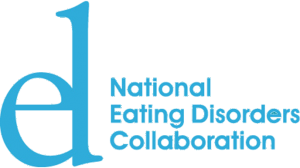 Eating disorders are rarely just about eating or food. They are serious and complex emotional and physical issues and are often a coping strategy used to deal with deeper, underlying problems or emotional conflicts which may be too painful or difficult to address directly. People rarely choose to have an eating disorder but it arises as a result of multiple factors including genetic susceptibility; neurobiological abnormalities (particularly in the body’s hypothalamic-pituitary-adrenal axis and the neurotransmitters they release – serotonin, norepinephrine, and dopamine); cultural and social pressures; and physical and emotional stressors.
Eating disorders are rarely just about eating or food. They are serious and complex emotional and physical issues and are often a coping strategy used to deal with deeper, underlying problems or emotional conflicts which may be too painful or difficult to address directly. People rarely choose to have an eating disorder but it arises as a result of multiple factors including genetic susceptibility; neurobiological abnormalities (particularly in the body’s hypothalamic-pituitary-adrenal axis and the neurotransmitters they release – serotonin, norepinephrine, and dopamine); cultural and social pressures; and physical and emotional stressors.
Individuals with eating disorders are not always underweight. More often than not, you cannot tell whether a person has an eating disorder merely by looking at them nor is the severity of their eating disorder dictated by their weight. A person can be extremely ill or malnourished whilst maintaining a normal or above normal weight.
 The Eating Disorders Association Inc (QLD) produced a comprehensive booklet in 2014 entitled Understanding Eating Disorders. It contains up-to-date information regarding the description of eating disorders, including Anorexia Nervosa, Bulimia Nervosa, Binge Eating Disorder, Other Specified Feeding or Eating Disorder and Unspecified Feeding or Eating Disorder (e.g. Pica, Rumination Disorder, Avoidant or Restrictive Food Intake Disorder); as well as information on the Clinical Diagnosis of Eating Disorders; Seeking Help; Recovery Strategies; Treatment Options; How Family and Friends are Affected; What Family and Friends Can Do; and Recovery Stories. This booklet is free to download by clicking on the highlighted title above or the image on the right. You can also access further information on their website www.eda.org.au.
The Eating Disorders Association Inc (QLD) produced a comprehensive booklet in 2014 entitled Understanding Eating Disorders. It contains up-to-date information regarding the description of eating disorders, including Anorexia Nervosa, Bulimia Nervosa, Binge Eating Disorder, Other Specified Feeding or Eating Disorder and Unspecified Feeding or Eating Disorder (e.g. Pica, Rumination Disorder, Avoidant or Restrictive Food Intake Disorder); as well as information on the Clinical Diagnosis of Eating Disorders; Seeking Help; Recovery Strategies; Treatment Options; How Family and Friends are Affected; What Family and Friends Can Do; and Recovery Stories. This booklet is free to download by clicking on the highlighted title above or the image on the right. You can also access further information on their website www.eda.org.au.
 The National Eating Disorders Collaboration (NEDC) also has some easy-to-read fact sheets which can be accessed via their site www.nedc.com.au or by clicking on any of the headings below. In addition to the fact sheets below, the NEDC has a great directory of services and support organisations for all states of Australia. It is worth checking their website out!
The National Eating Disorders Collaboration (NEDC) also has some easy-to-read fact sheets which can be accessed via their site www.nedc.com.au or by clicking on any of the headings below. In addition to the fact sheets below, the NEDC has a great directory of services and support organisations for all states of Australia. It is worth checking their website out!
Anorexia
Anorexia Nervosa is a serious and potentially life threatening mental illness. A person with Anorexia Nervosa has not made a ‘lifestyle choice’ to pursue a socially desirable thin body, they are actually very unwell and need help.
Bulimia
Bulimia Nervosa is a serious mental illness that requires treatment; it is not a lifestyle choice. Bulimia Nervosa is characterised by repeated episodes of binge eating followed by compensatory behaviours.
Binge Eating
Binge Eating Disorder is a serious mental illness characterised by regular episodes of binge eating. A person with Binge Eating Disorder will not use compensatory behaviours, such as self-induced vomiting or over-exercising after binge eating. Many people with Binge Eating Disorder are overweight or obese.
Other Specified Feeding and Eating Disorders (OSFED) – Previously known as Eating Disorder Not Otherwise Specified (EDNOS)
A person with Other Specified Feeding and Eating Disorders (OSFED) may present with many of the symptoms of other eating disorders such as Anorexia Nervosa, Bulimia Nervosa or Binge Eating Disorder but will not meet the full criteria for diagnosis of these disorders.
Disordered Eating and Dieting
Disordered eating is when a person regularly engages in destructive eating behaviours such as restrictive dieting, compulsive eating or skipping meals. Disordered eating and dieting behaviour are the most common indicators of the development of an eating disorder.
Body Image and Body Image Snapshot Poster
Body image is the perception that a person has of their physical self, but more importantly the thoughts and feelings the person experiences as a result of that perception. It is important to understand that these feelings can be positive, negative or a combination of both and are influenced by individual and environmental factors.
Eating Disorders in Males and Guys get Eating Disorders Too
While eating disorders are often portrayed as disorders that only affect females, one in ten people diagnosed with an eating disorder are male. However, we also know that the under-diagnosis and the cultural stigma boys and men face means that the actual proportion of males with eating disorders could be much higher.